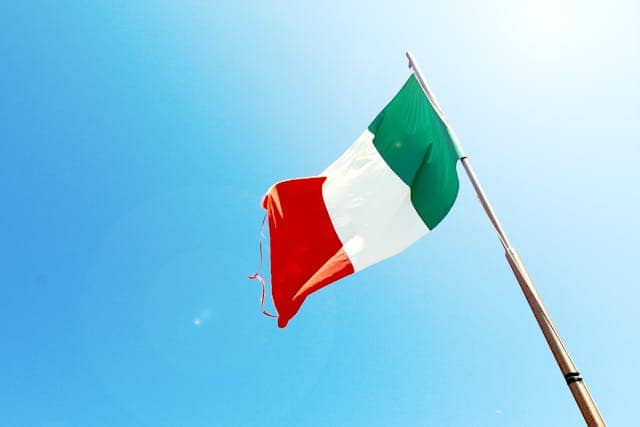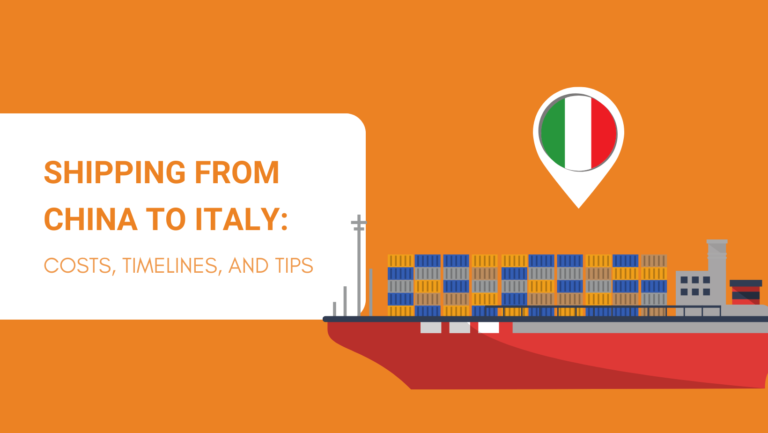Shipping from China to Italy encompasses a complex web of logistics and transportation options crucial for importers and exporters operating in global trade.
Understanding the intricacies of this trade lane is essential for timely and cost-effective deliveries.
Whether you are new to international shipping or seeking to optimize your supply chain, navigating the options from major Chinese and Italian ports, grasping customs regulations, and choosing the right freight forwarder are pivotal steps in your logistics planning.
Your goal is to gain a comprehensive understanding of the shipping process from China to Italy, including various transport methods, schedules, and budget considerations.
This article aims to provide a detailed guide, equipping you with the knowledge to make informed decisions regarding your cargo and ensuring a smoother transit to its final destination in Italy.

Shipping Methods
When you’re exporting goods from China to Italy, you have multiple shipping methods to consider, each with its unique advantages and disadvantages. Let’s break them down to ensure you choose the most effective option for your needs.
Air Freight
Air freight offers fast delivery from airports like Shanghai Pudong International Airport to major Italian airports such as Milan-Malpensa. It’s ideal for time-sensitive shipments or perishable products.
Pros
- Swift transit time (3-7 days)
- Reliable scheduling
- Extensive tracking options through courier companies like FedEx or DHL
Cons
- Higher cost compared to other methods
- Limited by airport capacity and air shipping regulations
Ocean Freight
Ocean shipping, whether via FCL (full container load) or LCL (less than container load), is a more economical choice for large shipments. Major ports like Ningbo-Zhoushan facilitate sea freight to Italian ports such as Genoa or La Spezia.
Pros
- Cost-effective for large volumes
- Good for bulky or heavy items
- Versatile packaging options (containers, pallets, cartons)
Cons
- Slower transit time (29-41 days)
- More complex customs clearance
Top-Rated China Freight Forwarder
Expert Shipping Solutions for Your Needs
Rail Freight
The New Silk Road, part of the Belt and Road Initiative, provides overland rail freight options. It strikes a middle ground between air and sea freight in terms of cost and speed.
Pros
- Faster than sea freight (2-3 weeks)
- Often cheaper than air freight
- Eco-friendly option
Cons
- Limited routings compared to ocean and air
- Affected by geopolitical situations
Express Shipping
If your shipments are urgent and small, express shipping can be your quick fix. Courier companies provide door-to-door pick-up and delivery with comprehensive tracking.
Pros
- Fastest delivery (2-3 business days)
- Direct pick-up service
- Ideal for small shipments
Cons
- Most expensive on a per-unit basis
- Size constraints on packages
Major Chinese and Italian Ports and Airports

When shipping from China to Italy, understanding the key logistics hubs is vital for efficient operation. In China, some of the most significant ports include:
- Shanghai: The Port of Shanghai is the world’s busiest container port, serving as a critical gateway for international trade.
- Shenzhen: The Port of Shenzhen comprises multiple smaller ports and caters to a massive volume of trade, thanks to its proximity to Hong Kong.
- Ningbo-Zhoushan: This port complex facilitates a large array of cargo types and boasts impressive handling capacity.
- Guangzhou: The Port of Guangzhou is an important hub for both marine and river shipping, playing a pivotal role in the regional economy.
- Hong Kong: With its deep natural harbor, the Hong Kong International Airport is one of the world’s largest cargo airports, perfect for air freight.
In Italy, the following ports are key entry points for goods arriving from China and the rest of Asia:
- Genoa: This port is Italy’s largest seaport and a principal commercial outlet for Northern Italy and much of Central Europe.
- La Spezia: La Spezia serves as a fundamental gateway for international trade and is well-equipped to handle container ships.
- Naples: The Port of Naples is one of the busiest in the Mediterranean and offers both passenger and cargo services.
Regarding major airports, exporters and importers ought to consider these facilities:
- Shanghai Pudong International Airport: A crucial airport for air cargo entering or leaving China.
- Milan Malpensa Airport: Italy’s second-busiest airport and a principal air cargo hub that links to several Asian destinations.
- Rome Fiumicino Airport: Also known as Leonardo da Vinci Airport, it is well positioned for connecting Italy with international markets.
Strategically choosing the right ports and airports based on your shipping needs can significantly streamline your operations. Ensure to check the current information on each of these hubs to plan your logistics effectively.
Cost Analysis and Budgeting

When planning to ship goods from China to Italy, it’s imperative to conduct a thorough cost analysis to ensure your budgeting aligns with the actual expenses.
Various factors will affect the price, including the shipping method, the volume and weight of the shipment, the type of goods being transported, and the urgency of delivery.
Here’s a breakdown of what influences the cost of shipping:
- Shipping Method: Air freight is faster but generally more expensive than ocean freight. On the contrary, ocean freight is economical for large shipments and allows for Full Container Load (FCL) or Less than Container Load (LCL) options.
- Cargo Type: Fragile, perishable, or hazardous materials can attract higher fees due to special handling requirements.
- Supply Chain Length: The longer the journey or the more transfers involved, the higher the cost.
- Timing: Peak seasons lead to higher rates due to increased demand.
As for budgeting, the cheapest way to ship from China to Italy is typically via sea transport for non-urgent, large-volume shipments.
Here’s an estimated pricing table for different shipping options:
| Shipping Method | Estimated Price Range |
| Sea Freight (20-ft Container) | $3,050 – $4,550 |
| Sea Freight (40-ft Container) | $4,150 – $5,850 |
| Air Freight | $8 – $20 per kg |
| Rail Freight (LCL) | $3 per kg |
| Rail Freight (FCL) | $4,000 – $6,000 |
These prices are subject to change based on the economic factors previously mentioned. Always request current quotes from freight forwarders and consider additional costs like insurance, tariffs, and warehousing.
By understanding these components, you’ll be able to budget effectively and mitigate the financial risks involved in international shipping. Remember, meticulous planning and research are your keys to a cost-effective shipment.
Transit Times and Scheduling

When you’re looking into shipping options from China to Italy, understanding transit times and scheduling is crucial for a successful transaction, especially if you’re dealing with time-sensitive shipments.
Transit times vary depending on the mode of transportation. For instance, air freight options can get your goods to Italy relatively quickly, often within 5 to 10 days. This method is suitable for fast delivery needs, albeit generally more costly.
If you have more time and wish to save on costs, shipping by container ship might be your choice, with average transit times ranging roughly from 21 to 40 days, based on the specifics of your selected shipping route and the ports of departure and arrival.
Timely scheduling is key to ensure your shipments align with your inventory requirements. Here, fixed schedules can aid in planning and certainty regarding delivery times.
Yet, remember that several factors can affect shipping schedules, such as customs clearance processes, seasonal fluctuations in demand, and unforeseen delays like inclement weather or port congestions.
Below is a table summarizing the shipping options and average transit times:
| Shipping Method | Average Transit Time | Considerations |
| Air Freight | 5 – 10 days | Faster, higher cost, good for urgent shipments |
| Container Ship | 21 – 40 days | Economical, longer transit, subject to sea conditions and port efficiency |
In planning your shipment, it’s vital to evaluate both your time constraints and budget. Always keep abreast of current shipping schedules to ensure you make the best decision for your logistical needs.
Customs Regulations and Documentation
When shipping from China to Italy, you must understand the necessary customs clearance process and documentation to ensure a smooth transaction.
Essential Documents for Customs
- Commercial Invoice: This document lists the goods in your shipment, their value, and provides proof of the transaction.
- Packing List: Details the items in your consignment and their specifications, aiding customs officers in checking the cargo.
- Certificate of Origin: Specifies the country in which the goods were produced, which is important for determining customs duties.

Remember, Italy follows the Union Customs Code (UCC), adopted in 2013, which sets forth regulations on the importation of goods into the EU.
Understanding Duties and Taxes
You’ll need to pay customs duties and taxes based on the value of the goods, their nature, and their origin. The process is streamlined if your paperwork is in order.
The UCC also outlines the incoterms—the trade terms that clarify the roles of buyers and sellers in international shipping.
Import Regulations
Italy enforces specific import regulations that you must comply with. Familiarize yourself with these rules, as non-adherence can result in delays or fines.
Finalizing Clearance
Your shipment’s clearance through customs will be contingent on accurately declared contents, values, quantities, and any required permits or certifications. Prepare all documents in advance to minimize clearance time.
By ensuring all your documentation is present and correct, you’ll navigate the shipping process from China to Italy with confidence.
Choosing the Right Freight Forwarder
When importing from China to Italy, finding a freight forwarder you can trust is essential. A freight forwarder acts as an intermediary between you and the transportation services, simplifying the logistics of shipping goods across international borders.
1. Research and Compare
Start with researching and comparing freight forwarders based on their service quality and competitive prices. It’s not just about who offers the lowest rate, but who provides the best value for your money.
2. Reputation and Reliability
Ensure they have a solid reputation and a reliable track record. Look for customer reviews or testimonials about their export and import services.
3. Industry Expertise
A forwarder with experience in trading partners and specific market knowledge can help navigate customs regulations and documentation requirements.
4. Range of Services
Assess the range of services offered. Do they provide comprehensive solutions like warehousing, distribution, or cargo insurance?
By following these steps, you’ll be well on your way to selecting a freight forwarder that aligns with your business needs and ensures the safe, timely, and cost-effective arrival of your merchandise.
Top-Rated China Freight Forwarder
Expert Shipping Solutions for Your Needs

FAQs about Shipping from China to Italy
Navigating the intricacies of shipping from China to Italy involves understanding customs fees, tracking procedures, clearance times, and prohibited items. This section covers key queries to help you manage your freight efficiently.
How Much Is Customs Fee in Italy?
The customs fee in Italy is not a fixed amount; it varies based on the value and type of goods you’re importing.
Italy’s customs authority calculates duties and taxes according to the HS code, product value, and origin country.
It’s prudent to consult with a freight forwarder or customs broker to estimate the exact fees for your shipment.
How Can I Track My Shipment from China to Italy and Ensure It’s Delivered on Time?
To track your shipment from China to Italy, use the tracking service provided by your freight forwarder or shipping company.
For timely delivery, opt for reliable couriers like FedEx, UPS, or DHL, which provide detailed tracking and faster transit times. Ensure that all necessary documents are prepared in advance to avoid delays.
How Long Does Customs Clearance Take in Italy?
Customs clearance in Italy typically takes between 1-2 days. However, the duration can be longer if there are issues with your paperwork or if inspections are required.
To expedite clearance, ensure all shipping documents and import declarations are accurately completed and provided promptly to the customs authorities.
What Items Are Not Allowed to Ship to Italy?
There are several items you’re prohibited from shipping to Italy, including counterfeit goods, hazardous materials, and certain food products.
Regulations also bar the entry of items like ivory, cultural artifacts, and drugs without proper authorization. For a complete list of prohibited items, refer to Italy’s customs regulations. Always check the latest restrictions before shipping, as they may change.
Last Port of Call: Shipping from China to Italy
Navigating shipping from China to Italy takes preparation but pays off in efficient operations. Follow the advice here to choose the right method, budget accurately, meet schedules, and clear customs without trouble.
If you’re looking to get a tailored plan for your shipping needs, don’t hesitate to seek a quick quote from us at NicheSources. We’ll take into account your specific requirements and help make your shipping experience as smooth as possible.
For a comprehensive logistics solution, consider our freight forwarding services. We offer end-to-end support, handling everything from pickup at the supplier to final delivery in Italy. To get started with a customized shipping plan that includes freight forwarding, request a freight forwarding quote today.

